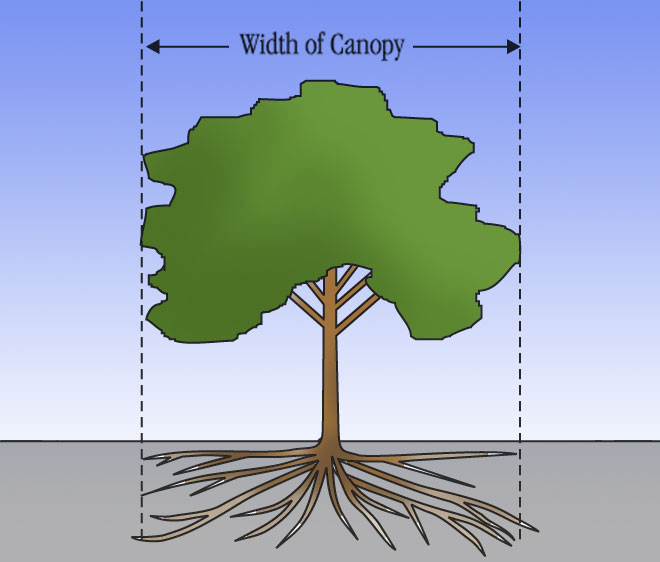Use this checklist to help you select the right tree.
1. What do you want the tree to do? (Pick one or more.)
- Shade
- Windscreen
- Visual screen
- Accent
- Colorful fruit
- Flowers
- Focal point for your landscape
- Grow fast
- Grow slow
- Grow tall
- Stay small
- Other ___________________________________________________________________

2. How much space does the tree have to grow? Are there any obstacles overhead, to the side, at ground level, or even underground?
Tree shade is better than Venetian blinds, plastic coatings, or reflective glass surfaces at cooling your home on hot, sunny days. Shading walls and windows can reduce air conditioning energy costs by 30 percent or more.
If obstacles are near the site, how far away from the planting site are they? They must be far enough so that the top, canopy, or roots of the tree do not interfere with these obstacles when the tree is at its mature size and maximum growth range. It’s important to note that roots can extend two to three times beyond the canopy. With most trees, however, the roots with the greatest potential to cause damage are generally found within the area under the canopy.
- No power lines overhead -If you are planting near power distribution lines that run through residential areas, the most important thing to remember is the 30-FOOT RULE: Trees and plants within 30 feet of power lines should not grow higher than 30 feet tall when fully grown. Consult your nursery or landscape professional for trees whose mature height does not exceed 30 feet.
- No buildings in close proximity – Don’t plant trees that can grow large enough to contact buildings or block signs. Trees that grow over roofs and rain gutters can create maintenance problems and damage buildings.
- No underground utilities – Do not dig or plant until you identify all nearby underground utility lines, including cable, sewer, and power lines.
– Do not plant trees on top of underground lines.
– Do not plant trees with aggressive roots near underground utilities where their roots can damage the facilities. - No swimming pools near site – If trees will be near a pool, select trees that do not drop leaves that will fall or blow into the pool.
- No plants or other landscape features that may suffer in the shade of a large tree – Ensure that large trees will not grow over and shade out smaller trees, shrubs, and groundcovers.
- No obstruction of scenic views – Ensure that the tree will not grow to block a desirable view for you or your neighbors.
- No nearby driveways/roadways/sidewalks – Select trees that have a high, clear trunk or that can be practically pruned so as not to obstruct safe travel.
– Do not plant large trees near driveways, roadways, curbs, and sidewalks where their roots may cause damage. - No nearby walls to undermine Do not plant large trees near walls. Their roots may cause damage to them!
- No nearby property boundaries – Do not plant trees where roots can invade and damage neighboring properties.
- Other considerations – It’s important to identify and avoid any obstacles that could restrict the canopy and root growth of your tree, or could be damaged by any part of your tree. Also, identify any situation where your tree could create a safety hazard or nuisance.
3. How are the planting conditions at the site?
Select a tree that will thrive or at least tolerate the growing conditions of the planned site.
- Quality of sunlight – Is there sufficient sunlight to ensure proper growth?
– Direct all day-Filtered through overhead obstacles
– Shade - Sufficient natural water – Natural availability of water may limit the selection of trees suitable for the site, without artificial irrigation.
– Dry
– Wet
– Moderate
- Quality of soil – The type of soil on site may limit your selection of plants to tolerant species.
– Heavy clay
– Sand
– Nice topsoil
- Depth of the soil – Make sure the soil is deep enough to support the tree’s root system. Most of the tree’s roots are confined to the top two feet of the soil layer. A large tree may be inappropriate for shallow or unstable soil.
- Exposure to salt spray – If the planting site is near the beach, make certain that the tree you select is salt tolerant.
- Usual strong winds – If the site is windy, are the trees sensitive to or damaged by strong winds?
4. Will the tree grow well in your neighborhood?
One easy way to answer this question is to take a look around your neighborhood. See how others have used trees in their landscaping design and find out what kinds of trees are growing well. Your local plant nursery can also suggest appropriate trees for your climate and soil conditions.
5. How much maintenance does the tree require?
If cleanup is a concern, don’t plant trees that are deciduous or messy.
- Is the tree low maintenance?
- Does the tree drop lots of leaves and/or fruit?
- What kind of maintenance can you reasonably provide?